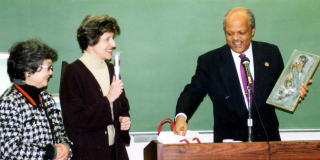UNESCO Lecture “Charm of Haiti”
|
 Lecturer: The ambassador of the Republic of Haiti to Japan, Monsignor
Marcel Duret
Lecturer: The ambassador of the Republic of Haiti to Japan, Monsignor
Marcel Duret Interpreter: Mrs. Suzanne Akieda
Time and Place: February 25th (Mon), 18:30-20:30 at Moriya Kyoiku Kaikan
with about 70 attendees.
Organizer: Meguro Board of Education
Administrator: Meguro UNESCO Association
Surrounded by colorful pictures of Haiti, and the aroma of coffee presented
by the embassy hanging in the air, the ambassador began his talk.
He engages daily in diplomatic activities in the belief that an important
role of a diplomat is to “make efforts towards mutual communication by
building a bridge of culture and fraternity between Haiti, his native country,
and Japan, his place of appointment. The production of the film, “Haiti,
Coeur Ballant” (Haiti, spiritual exaltation) is one of the activities
to realize his dream. It will be completed soon and released this summer.
We had the honor of seeing the film for the first time as an audience.
The following is the summary of his lecture.
The Culture of Haiti is complex. It has three different roots: a native
Indian culture, a European culture, and an African culture. They have dualism
in that two languages, French and Creole, are spoken, two religions, Christianity
and Voodoo, are believed in, and society consists of city dwellers and
villagers. The soul of Haitian culture is seen mostly in common people,
city streets, homes in villages and mountain villages, dirt, and often
in poverty and misery. Just like all other great works of art, pain exists
at the heart of the culture. This may be the reason why Haiti itself is
said to be a work of art.
There are pictures everywhere, on the walls, the streets, and the doors
and bonnets of taxis. A great French writer and critic, André Malraux,
praised the pictures of Haiti highly saying, “In Haiti everybody is an
artist, which is not the case in any other country.”
Music is also one of the most interesting expressions in Haitian culture.
Most music compositions by Caraibes have their roots in Haiti. Music such
as Kompa, Racine, Troubadours and Voodoo are characterized by many kinds
of rhythm brought over from Africa.
Religion in Haiti: It is often said that 90% of the people in Haiti are
Voodooists, and 80% are Catholics. It seems to be somewhat like Japan,
where 85% are Buddhists and 80% are Shintoists. Voodoo is practiced in
the daily lives of 70% of the people, and can be said to be the soul of
the culture.
History of Haiti: 198 years ago in 1804, people in Haiti defeated Napoleon’s
mighty army to establish the world’s first independent nation ruled by
black people, the Republic of Haiti. Brave heroes of the nation such as
Jean-Jacques and Dessalines declared to the world that on that day, freedom
gained a name, and that name was Haiti. It can be said that the declaration
of independence rang the death knell for slavery. It was a valuable contribution
to world history and culture. The revolution occurred amidst a huge volume
of slave trafficking. For 4 centuries, 14 million people were bought and
sold, crammed like livestock into the bottom of ships. Of these, more than
2 million African brothers and sisters died during the passage over the
Atlantic Ocean. The revolution served to abolish that despicable trading.
The Present State and our Request: We will celebrate the 200th anniversary
of independence on January 1st, 2004. Unfortunately, most of the people
are still living in poverty and ignorance. 60% of  adults are illiterate. Even as late as the 20th century, more than 4 million
people were unable to get an education. Just 1% of Haitians control 60%
of the GNP, and there is only one doctor available for 10,000 people. The
child mortality rate is as high as 12%.
adults are illiterate. Even as late as the 20th century, more than 4 million
people were unable to get an education. Just 1% of Haitians control 60%
of the GNP, and there is only one doctor available for 10,000 people. The
child mortality rate is as high as 12%.
We are thinking of promoting a campaign for funds, utilizing the film
“Haiti, Coeur Ballant” so that by the year 2004 all children in Haiti
will be granted basic human rights, be educated, receive a health service
and have at least one meal a day. I sincerely appreciate your warm cooperation.
I hope many people will attend the 200th anniversary of independence of
Haiti on January 1st, 2004.
The upper right picture shows Ambassador Duret, Mrs. Suzanne Akieda (French
interpreter), and President Kato on the right. Many presents including
the woodcraft work held by the ambassador were given to attendees by lottery.
The picture at the bottom shows the room surrounded by many pictures. The
painting on the rostrum was presented to the president of Meguro UNESCO
Association, Ms. Kato.
Reported by Harada.
185-4へ
 Lecturer: The ambassador of the Republic of Haiti to Japan, Monsignor
Marcel Duret
Lecturer: The ambassador of the Republic of Haiti to Japan, Monsignor
Marcel Duret Lecturer: The ambassador of the Republic of Haiti to Japan, Monsignor
Marcel Duret
Lecturer: The ambassador of the Republic of Haiti to Japan, Monsignor
Marcel Duret adults are illiterate. Even as late as the 20th century, more than 4 million
people were unable to get an education. Just 1% of Haitians control 60%
of the GNP, and there is only one doctor available for 10,000 people. The
child mortality rate is as high as 12%.
adults are illiterate. Even as late as the 20th century, more than 4 million
people were unable to get an education. Just 1% of Haitians control 60%
of the GNP, and there is only one doctor available for 10,000 people. The
child mortality rate is as high as 12%.